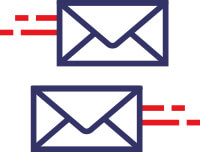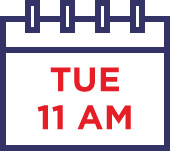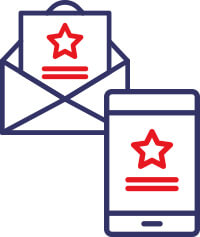
For many companies, the holidays are a crucial time to drive business. Marketers need a fine-tuned plan to capitalize on the busy shopping season and attract customers. Some marketers include email in their holiday marketing mix, others choose to focus on direct mail. But choosing one channel over the other could do your business a disservice.
By combining email and direct mail, you can target and convert consumers even more effectively. For example, in one study, businesses increased their order value by more than $3 when using the two mediums combined; they also saw a 25% response rate.[1] Learn about the benefits of email and direct mail, and best practices for creating a campaign that uses both channels in sync.
Two Potent Channels
Email and mail can make a real impact on holiday sales.
Email has serious reach.
eMarketer estimates that by 2021, there will be 266.3 million email users in the U.S.[2]
Direct mail has a high return on investment (ROI).
A 2016 report showed that, in the U.S., direct mail has a 27% median ROI.[3]

Email campaigns convert more with a house list.
The same report showed the following conversion rates:
House list rates:
- 21% open rate
- 10% click-through rate
- 5.5% conversion rate
Prospect list rates:
- 16.4% open rate
- 5.9% click-through rate
- 4.3% conversion rate[4]
Personalization makes a difference for both channels.
One study showed that brands that personalize the subject lines of their emails experience 27% higher unique click rates and 11% higher open rates than those that do not personalize their promotional emails.[5]
By personalizing a direct mail campaign with a customer’s name and location, one company achieved a 9.7% conversion rate.[6]
Using both channels in tandem can capture more consumer attention during the holidays.
According to a study by Canada Post, marketing campaigns that integrate direct mail and digital media hold 39% more of a customer’s time than digital campaigns alone.[7]
Consumers prefer email and direct mail during the holidays.
A 2017 survey showed that internet users most preferred email and direct mail to receive their holiday deals.[8]
How to Create a Multichannel Campaign
Consider these best practices when implementing a holiday campaign featuring email and direct mail.
Decide on the optimal timing. 1
When planning a direct mail and email campaign, mail is typically the first touchpoint. Once the mailpiece is sent, choose two to four different moments to send out emails. The first email should go out a week after the mailing to keep the original mailing top of mind. Send the other emails a few days apart to not overwhelm the recipient. According to HubSpot, Tuesday is the best day of the week to send an email, while 11 a.m. EST sees the highest email click-through rates.[9]

Make sure your branding aligns. 2
Creative elements in the mailpiece and subsequent emails should match. Leverage the copy and visuals you’re using for your holiday campaigns in both. For example, your holiday tagline can be used in the header copy of the mailpiece and the subject line of your first email or its body copy. Be sure your mail and email also lead to the same final touchpoint—whether it’s your website or a holiday microsite.

Personalize the content. 3
Help boost conversion rates by personalizing the copy in your mailpiece. For example, you could include the name of the recipient in header copy and customize content in the rest of the mailpiece to their specific customer segment. For the first email sent out, consider including the recipient’s name in the subject line. This small change can bump up email open rates and direct mail responses.

Use a comprehensive mailing list for your campaign. 4
Creating a house or prospect list for your campaign will be more complicated, since you’ll need to match email addresses to physical addresses. For a house list, work with your internal teams to merge the address data you already have. For a prospect list, work with a list supplier that can tap into a multichannel database. You don’t want to buy a list that’s missing email or physical address information for the same prospect.

Consider using retargeted direct mail instead of a list. 5
The latest trend in direct mail leverages programmatic technology to send personalized mailpieces triggered by digital interactions. You’ll need to be sure the programmatic database has customer information that includes email and physical addresses. Once a visitor interacts with a specific touchpoint on your site—whether your homepage, a category page or product page—the programmatic technology will send a mailpiece within 24 to 48 hours of the interaction.

Summary
Nailing down the right marketing mix during the holidays is crucial for year-round success. Sync up your email and direct mail efforts instead of choosing one channel over the other. With a well-timed, well-designed campaign, your business could see increased sales during the holidays.
Footnotes
keyboard_arrow_down- [1]Arthur Middleton Hughes, “Why Email Marketing Is King,” Harvard Business Review, August 21, 2012. arrow_right_alt
- [2]“Email Users, US 2018 – 2022,” eMarketer, 2018. arrow_right_alt
- [3]“2016 Response Rate Report,” Direct Marketing Association and Demand Metric, as cited by eMarketer, September 12, 2016. arrow_right_alt
- [4]“2016 DMA Response Rate Report,” Data & Marketing Association, 2016. arrow_right_alt
- [5]“New insight from Experian Marketing Services helps brands prepare for the holiday season,” Cheetah Digital, formerly Experian Marketing Services, August 25, 2016. arrow_right_alt
- [6]Aja Frost, “The Ultimate Guide to Direct Mail,” HubSpot, January 12, 2018. arrow_right_alt
- [7]“Connecting for Action Study,” Canada Post, September 2016. arrow_right_alt
- [8]“Holiday Retail Insights Survey November 2017,”IFTTT, as cited by eMarketer, 2017. arrow_right_alt
- [9]David Ly Kim, “The Best Times To Get Your Business Email Opened, Based on Data From 20 Million Emails” HubSpot, 2015. arrow_right_alt
 search
close
menu
search
close
menu



